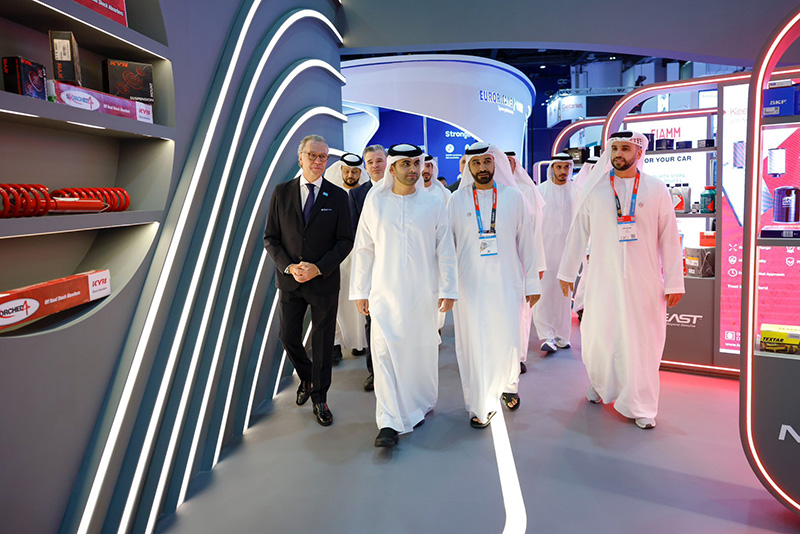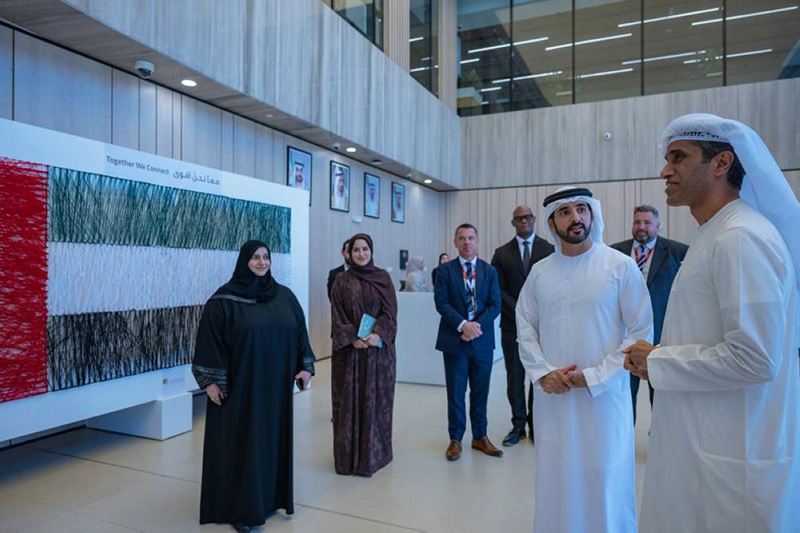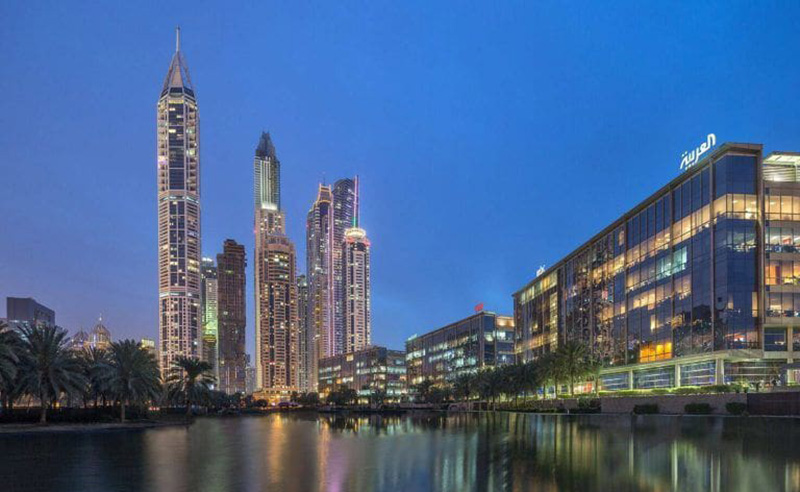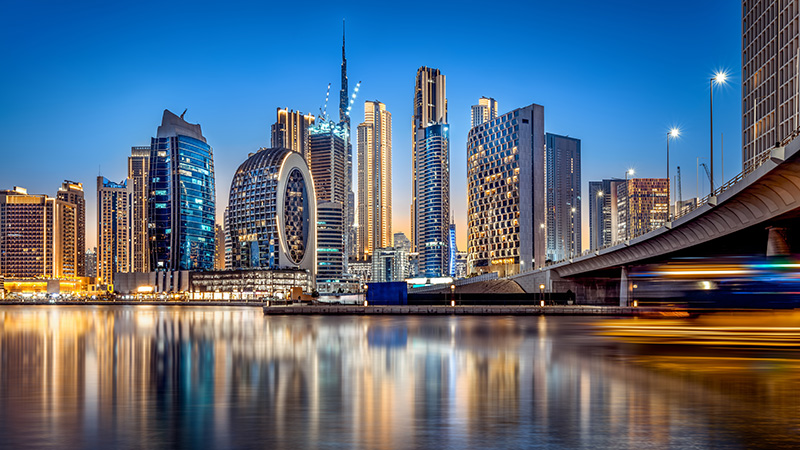
Since the close of the 20th century, data has ascended to rival the world’s most prized natural resources. No longer simply a technical asset, information—along with the digital infrastructure that houses and processes it—has become the lifeblood of the modern global economy. Today’s invisible “digital warehouses” serve as the backbone of the digital age and the engine of what is now widely termed the information revolution—one that is reconfiguring the foundations of power and development around the world.
Against this backdrop of global transformation, the United Arab Emirates emerged in the early 2000s as one of the region’s most daring digital pioneers. At a time when much of the Arab world was still taking its first tentative steps toward internet connectivity, Dubai made a bold and unprecedented move toward the digital future. The establishment of the UAE’s first world-class data center—through a partnership between Dubai Internet City and IBM—marked a pivotal moment not only for the nation, but for the entire region. It laid the groundwork for a digital launchpad that would drive the Middle East’s transition into a knowledge-based economy.
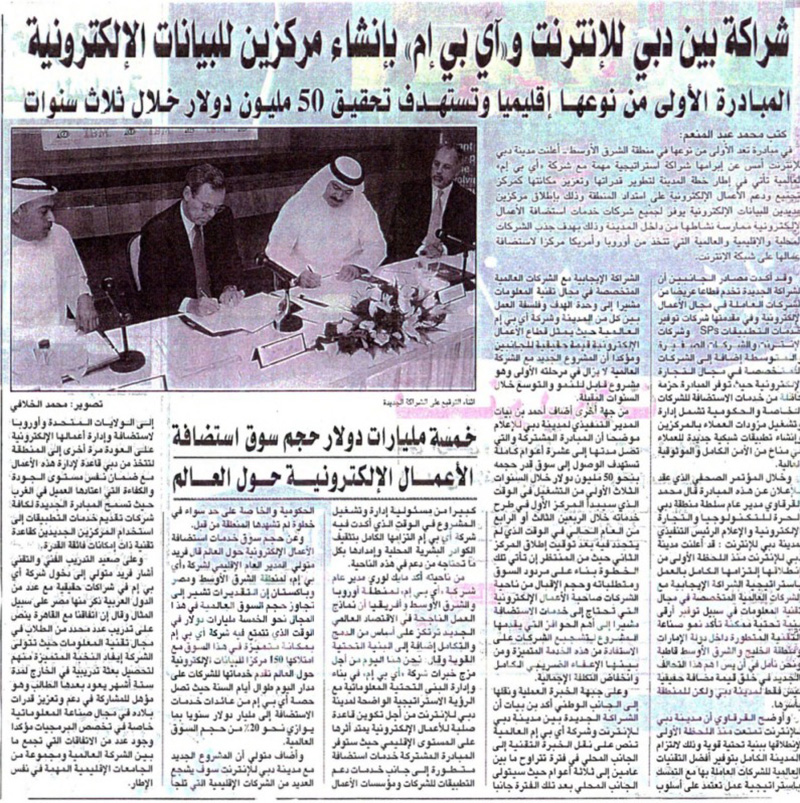
The Genesis of a Data Powerhouse: Dubai and IBM’s Bold Partnership
In 1999, then-Crown Prince Sheikh Mohammed bin Rashid Al Maktoum unveiled an ambitious vision: to position Dubai as the regional capital of the digital economy. That vision quickly took shape with the founding of Dubai Internet City, a technology-focused free zone designed to attract the world’s tech giants and foster a new ecosystem for digital growth.
Within this context—and at a time when the region’s technological infrastructure was nascent at best—Dubai conceived of an ambitious plan to build a world-class data center that would host internet services and e-business platforms for the broader Middle East. The choice of IBM as a strategic partner was no accident; the American technology conglomerate brought unmatched expertise, credibility, and execution power to the project.
By the early 2000s, Dubai and IBM had inaugurated the e-Hosting DataFort center inside Dubai Internet City. Sheikh Mohammed himself attended the launch of the facility, which was described at the time as the first of its kind in the Middle East. Designed and built under the direct supervision of IBM experts, the data center provided advanced hosting capabilities to enterprises across the region—offering them a reliable, secure environment for critical IT infrastructure, far beyond what internal servers could offer.
In regional terms, the initiative was groundbreaking. In 2001, Dubai set a target of generating $50 million in revenue within just three years, by offering its data hosting services to local and regional firms. Contextually, this was an audacious goal—at a time when the global e-hosting market was valued at approximately $5 billion. A $50 million target implied a bold yet calculated bet on the region’s digital acceleration.
The move reflected the strategic assertiveness of Dubai’s leadership. While Western companies were investing heavily in digital infrastructure during the dot-com boom (1997–2000), the Middle East remained devoid of comparable capabilities. Rather than trailing by decades, Dubai made the decision to leap to the front of the digital curve.
And the bet paid off.
The data center quickly evolved into a trusted operational base for both global and regional enterprises, enabling them to deliver online services to the wider market with high availability and robust security. The success of the project validated Dubai’s early gamble and established a model that others across the region would seek to emulate.
Perhaps the most fitting encapsulation of this bold strategy came from Sheikh Mohammed himself, who declared:
“Digital excellence is a principle we have established for the next fifty years. We look forward to national ideas and global partnerships that accelerate our path toward leadership.”
The statement was a continuation of his longstanding belief that reaching the top in the global rankings could only be achieved through the seamless integration of cutting-edge technologies and operational excellence.
Dubai Internet City: From Local Ambition to Regional Digital Anchor
The launch of the UAE’s first data center was far from an isolated technical event—it was the cornerstone of a broader strategic vision that would soon elevate Dubai Internet City into an unprecedented digital springboard for the region. The data center provided essential infrastructure for the wave of technology, media, and telecommunications firms that began to flow into Dubai at the dawn of the new millennium. Within just a few years, Dubai Internet City had become home to over 1,600 tech companies, including global giants such as Microsoft, Oracle, and IBM itself. Crucially, the availability of localized hosting infrastructure meant regional firms no longer needed to rely solely on servers in Europe or the United States to operate their websites and digital services. For the first time, they could do so from within Dubai—with world-class reliability.
This momentum was further amplified in October 2004 with the establishment of Dubai Holding, the emirate’s new umbrella investment arm for major strategic projects. Under this structure, Dubai Internet City was reorganized into the TECOM Investments portfolio—a move that transformed the initiative from an innovative free zone into a formal pillar of Dubai’s economic diversification agenda. Backed by long-term capital, institutional governance, and a supportive network of sister clusters in media, education, and design, Dubai Internet City evolved into the region’s foremost internet gateway.
With this institutional support, the hub became the trusted address for global technology leaders in the Middle East and one of the region’s most powerful magnets for digital investment. Its role expanded rapidly—from data hosting to becoming a nucleus for artificial intelligence development and R&D activity. The result was a transformative advantage: between 1999 and 2014, Dubai Internet City contributed an estimated AED 100 billion (approximately USD 27 billion) to Dubai’s economy. By 2024, the zone accounted for roughly 65% of the emirate’s tech-sector GDP. These figures reflect the long-term returns on Dubai’s early infrastructure investment—having attracted thousands of firms and created over 125,000 direct and indirect jobs, the city became a foundational pillar of economic diversification.
At the regional level, Dubai Internet City offered a model for how Gulf nations could build a credible ecosystem for tech companies and knowledge-based industries. With world-class infrastructure—including its landmark data center in partnership with IBM—Dubai attracted digital talent, startups, and breakthrough ideas from across the Arab world and beyond. The city became a launchpad for the region’s firsts: early e-commerce platforms, digital music services such as Anghami, and pioneering e-government programs. The establishment of the data center was not merely a hardware installation—it laid the bedrock for all that followed.
Put simply, the center was not just a room of servers—it was a catalyst for economic transformation. It enabled the UAE to leap into the era of digital services and positioned Dubai as a global magnet for technology investment, drawing billions of dollars over the ensuing decades. As Sheikh Mohammed bin Rashid later observed during a visit to a digital facility,
“Our vision for the future is clear, and the requirements for excellence are well defined… We are pursuing them with the innovation, intellect, and energy of Emiratis.”
The country’s digital infrastructure had become a development cornerstone—its ignition sparked by that daring joint venture with IBM.
East vs. West: A Global Race for Digital Infrastructure
To appreciate the boldness of the UAE’s move, it is helpful to consider the global picture in the late 1990s and early 2000s. At the time, the United States and Western Europe were undergoing an explosive boom in data center development, driven by the rapid rise of the internet and the infamous dot-com bubble. Companies required high-speed, uninterrupted online access, prompting a surge in purpose-built facilities known as Internet Data Centers (IDCs). In this era, hosting giants like Equinix emerged in Silicon Valley, New York, and London, while major telecom players invested heavily in massive “collocation” centers—leasing space to businesses seeking secure, always-on server infrastructure.
By the year 2000, the U.S. had built an extensive network of these modern centers, especially in northern Virginia’s so-called “Data Center Alley” near Washington, D.C. America led the sector unchallenged, accounting for nearly half the world’s total data center capacity—a dominance it still maintains today. Meanwhile, Europe was also making strides, with landmark projects like London’s Telehouse Docklands (established 1990), which became a model for commercial data hosting across the continent.
In Asia, countries like Japan and Singapore were beginning to invest in digital infrastructure at the turn of the century. Singapore, for example, developed tech parks such as One-North, featuring high-spec facilities to attract global firms and capitalize on its position as a Southeast Asian connectivity hub. Even China and India, despite trailing slightly behind, began building large-scale centers to accommodate their booming internet user bases during the early 2000s.
In contrast, the Arab world was still heavily reliant on foreign servers throughout the 1990s. Dubai’s early decision to build a world-class, domestically housed data center by 2001 was, by regional standards, revolutionary. The timing and scale of the investment underscored the clarity and courage of Dubai’s vision. For context, while Dubai was targeting $50 million in revenue from its data center over three years, American companies like Exodus Communications were spending hundreds of millions—sometimes recklessly—on dozens of new facilities. Some eventually collapsed under financial strain. Yet the fundamental bet was the same: that whoever controlled the digital infrastructure—from fiber cables to data centers—would command the future.
The difference was that the UAE made this bet in a region that had barely begun to grasp the stakes. Dubai’s foresight enabled it to become the region’s reference model. In the years that followed, other Gulf countries—including Saudi Arabia and Qatar—rushed to develop similar facilities in a bid to catch up.
Data Centers: From Infrastructure to Sovereign Assets
Two decades on from Dubai’s first data center venture, the global investment landscape in digital infrastructure has entered an era of extraordinary acceleration. The race to build larger, faster, and more efficient facilities has intensified with the rise of technologies like artificial intelligence and cloud computing. Paradoxically, the Middle East—once a latecomer to the digital game—has become one of the fastest-growing regions in the sector. According to the World Economic Forum, the global data center industry is projected to reach $242.7 billion by 2025 and more than double to $584 billion by 2032. This signals hundreds of billions of dollars in annual global investment toward constructing and operating the new “factories” of the digital economy.
In this gold rush, emerging economies are no longer peripheral players. Countries like India, Brazil, Kenya, and the UAE are racing to attract data center investments, recognizing them as the arteries of future economies. Just as governments once competed to host car or electronics factories, they now offer tax incentives, fast-track permits, and dedicated land parcels to court data infrastructure projects.
From Millions to Hundreds of Billions: A Transformed Market
The scale and nature of investment in data centers has shifted dramatically. Dubai’s 2001 joint venture with IBM began with a $50 million vision—today, the global industry commands annual capital expenditures in the hundreds of billions. This is not just inflationary drift; it reflects a seismic economic and social transformation. Digital infrastructure has become as central to national development today as highways, airports, and power dams were to the 20th century.
Economically, data centers and cloud services have matured into standalone industries generating highly specialized employment and attracting massive capital inflows. In the early 2020s, global data center hardware spending surged to nearly $200 billion annually, driven by insatiable demand from tech giants like Amazon, Google, Microsoft, and Meta to expand cloud capacity. In the Gulf, recent reports show combined UAE and Saudi Arabia spending on data infrastructure reaching AED 1.5 billion in 2022, with annual growth hovering around 30%—a staggering figure compared to other sectors.
This transformation is reshaping labor markets. Where traditional utility operators once dominated, there is now surging demand for network engineers, cloud architects, and data center managers. Cities that host large-scale data centers benefit from the creation of high-value jobs in cybersecurity, systems administration, and software engineering.
Socially, this wave of investment has redefined public services and everyday life. Robust cloud infrastructure enables everything from smart education and telemedicine to real-time banking and digital entertainment. In the UAE, the local proliferation of data centers has underpinned high-speed, reliable digital government services and elevated public trust in digital applications—even during periods of peak demand. Proximity to infrastructure has enhanced digital inclusion: internet penetration in the UAE has skyrocketed from around 24% in 2000 to approximately 98% today. Meanwhile, the culture has shifted: data is now a strategic resource.
Digital Sovereignty and National Security: Data Centers as Strategic Assets
As data’s value has risen, so too has the strategic importance of where and how it is stored. Data centers have evolved from commercial ventures into national assets with security and sovereignty implications. Governments increasingly view them as critical facilities that must be protected, regulated, and maintained under domestic jurisdiction. Hosting citizen data within national borders is now a matter of national security—on par with defending territorial integrity or safeguarding energy infrastructure.
Many countries have enacted regulations mandating that government and sensitive-sector data (e.g., banking, telecom) be stored locally, within certified data centers, to protect privacy and avoid foreign legal entanglements. The UAE has led the Arab world in this space, with initiatives such as the National Cybersecurity Strategy emphasizing the creation of secure national cloud environments to ensure sovereign control over governmental data.
In addition to data sovereignty, large-scale data centers bolster a country’s digital defense capabilities. They host AI systems and big data analytics engines used in cybercrime prevention, infrastructure protection, and real-time threat detection. The ability to process billions of records instantly makes it possible to detect cyberattacks or analyze communications patterns to identify emerging risks. Accordingly, these centers are now protected with stringent physical security (biometric access, armed guards, 24/7 surveillance) alongside advanced cybersecurity protocols. Several nations have begun conducting joint drills to test their data centers’ resilience to cyber threats or prolonged power disruptions.
Moreover, these facilities are instrumental in enabling digital government transformation. A national data center allows for the centralization of disparate government databases—from population registries to education and health records—streamlining information exchange and improving service delivery. In Dubai, for instance, digital infrastructure played a central role in realizing the paperless government vision, slashing transaction times from days to minutes.
Economically, domestic data centers attract global companies that require local hosting for regional clients. This, in turn, stimulates a local market for managed services and cloud platforms, driving foreign direct investment. Already, global tech players such as Amazon Web Services and Microsoft Azure have launched cloud regions in the UAE, drawn by its mature infrastructure and favorable investment climate.
Transparency and competitiveness are also at stake. Open data policies, like those championed by the UAE, require trusted national platforms to publish non-classified government data and enable innovation. As Mohammed Al Gergawi, UAE Minister of Cabinet Affairs, has stated on several occasions:
“Our adoption of open data policies aims to accelerate digital transformation, enhance resource efficiency, and foster transparency.”
This vision has materialized through large-scale, secured national platforms housed in domestic data centers.
In summary, data centers have transitioned from mere commercial real estate to multidimensional strategic assets. They are foundational to knowledge economies, critical to national sovereignty, enablers of digital governance, and catalysts for economic transformation. Yet, their rapid expansion raises new sustainability concerns—particularly around electricity and water consumption. According to the International Energy Agency, data centers currently consume 1–1.5% of global electricity. For the UAE and others, ensuring that these facilities run on clean energy is fast becoming a policy priority.
A Vision That Engineered the Future
From humble “server rooms” tucked into back offices in the 1990s to sprawling hyperscale server cities emerging across the Emirates today, the region has undergone a remarkable digital metamorphosis. The story began with a bold decision by a leadership that believed the future could be designed—and built. When Sheikh Mohammed bin Rashid stood with IBM executives in 2001 inside a room packed with humming machines, they were inaugurating more than a technical facility. They were laying the digital foundation for a new era—one in which an Arab nation would claim a frontline role in the Fourth Industrial Revolution.
Two decades later, the UAE stands as a vital node on the global data center map, rivaling traditional tech capitals in scale and capability. Yet the true value of this journey lies not in statistics alone, but in the underlying vision: a belief in technology as a tool to empower people and society, and in data as a strategic asset to be leveraged for sustainable development. As Crown Prince Sheikh Hamdan bin Mohammed Al Maktoum recently noted,
“With Mohammed bin Rashid’s vision, Dubai is reinforcing its position as a global hub for digital innovation.”
This digital leadership is not merely a technological privilege—it is a civilizational responsibility, one that seeks to harness the information revolution for a better tomorrow.
Amid this relentless transformation, the words of Minister Mohammed Al Gergawi resonate with heightened urgency:
“We have now entered the second second of the first minute of the first hour of the first day of technological evolution.”
A powerful reminder that, for all the progress made, we remain at the earliest chapters of the digital age. And if there is one lesson from the UAE’s data center story, it is this: bold foresight, paired with timely strategic investment, can propel a nation from the sidelines of innovation to its very summit.
The UAE did just that—investing in a modest data center by today’s standards. And now, it reaps the dividends through regional and global leadership. It has proven, decisively, that whoever controls data, commands the future.
The history of data centers in the UAE reads like a chronicle of a race against time: from a solitary server room to seamless cloud infrastructure; from a nascent dream in the desert to a cornerstone of the world’s most ambitious AI ecosystems. It is the story of a nation that chose to embrace—not resist—its digital destiny. And while the beginning was a spark, all signs point to a future even more dazzling, where new chapters of global digital leadership are still waiting to be written. Because those who race ahead of the future, are the ones who shape it.
